by Melody Amsel-Arieli
To drum-beat and heart-beat,
A soldier marches by:
There is color in his cheek,
There is courage in his eye,
Yet to drum-beat and heart-beat
In a moment he must die.
– from Nathan Hale by Francis Miles Finch (1827-1907)
The Hudson River, which spans from northeastern New York State to the southern tip of Manhattan, had long been utilized for trade and travel. During the Revolutionary War (1775–1783), it also held great strategic importance.
If British forces seized the Hudson River Valley, they would not only control a critical military supply route from Canada through the Colonies. They would also isolate the Middle Colonies from New England, the heart of the Patriot Rebellion.
Though the country’s fight for independence is long over, Revolutionary Hudson River Valley encampments, skirmish sites, battlefields, military headquarters, and other historic spots still dot the Hudson River Valley. Through the years, many have yielded remnants of the past, assorted arms and militaria artifacts.
“Dug” items, still unearthed from time-to-time, have often cracked, chipped, bent, pitted, or oxidized underground. “Undug” items, stashed away in barns or attics, generally, survive in better condition.
Each defines the Revolutionary War in a personal, tangible way. It’s one thing to learn about a particular battle. It’s another to own an item that actually “touches history,” bringing that battle to life.
Colonial and British artifacts differed at the outbreak of the Revolutionary War. “Continental Minute and Militia companies initially armed themselves with whatever was at hand,” explains Joel Bohy, director of Historic Arms & Militaria at Skinner, Inc. “Civilian fowling pieces (used to shoot birds in flight), French arms captured from the French & Indian War, and guns cobbled together from found parts, for example, were counterparts of the arms used by forces of King George III. Colonial and British equipment also varies in appearance, material, and methods of manufacture.”
In time, both sides bore long, smoothbore, muzzle-loading, flintlock muskets. When a musket was triggered, its flint struck a steel plate creating sparks which ignited gunpowder in its priming pans. This set off main powder charges which discharged a single, marble-size musket ball.
Most Revolutionary War artifacts that reach auctions hail from collections prized by deeply passionate enthusiasts. Others were passed down from generation to generation. Their paths, through the past 50, 100 or 250 years, may prove as fascinating as their underlying military history. Yet their provenance is everything.
Revolutionary army muskets bore marks of battalions as well as numbers, Bohy reveals. “A recently auctioned British Pattern 1756 Long Land musket, for example, was initially ascribed to a certain regiment. Through further research, however, Skinner’s Historic Arms & Militaria experts were able to connect it to a more historically significant one.”
Another example, a French model musket, marked to the Continental Army 3rd Battalion, bore the initials NH and “167.” Research at the Massachusetts Historical Society uncovered an arms list for Captain Gray’s Company of the 3rd, indicating that it was issued to Enoch Thomas of Wolfborough, New Hampshire. Based on this information, experts discovered that he enlisted on May 2, 1777, fought at Valley Forge, then at the Battle of Monmouth in New Jersey.
“This musket was auctioned along with proof of provenance – copies of Gray’s Company arms list, as well as Enoch Thomas’ service and pension records,” Bohy explains. “Our research not only added interest to this artifact but also substantially increased its value. As appraisers, our deep understanding of the material, as well as its military and social history, allows us to put items into historical context.”
Lead or lead-alloy, hand-molded musket balls (as well as bullet and shot molds) also survived. Intact ones may have rolled from sight, sunk into wintry mud, or missed their targets. Malformed ones may have hit their targets. Others bear imprints of human molars. While bored or enduring corporal punishment, did Revolutionary soldiers “bite the bullet?”
Soldiers stored gunpowder in water-proof, funnel-like ox, cow, or buffalo horns. Scores feature engraved maps, pictorials, and/or owners’ names, dates, and places of production. Many display morale-boosting slogans like LIBERTY OR DEATH, SUCCESS TO AMERICA or KIL OR BE KILD. Some also boast original butt plugs.
Aficionados may also find half-pikes, battles-axes, and bayonets, which transformed British muskets into in-your-face spears, captivating. Some seek resplendent bone or ebony-handled French rapiers, horsemen’s sabers, or officers’ swords featuring ornamental engravings. Others prefer small personal arms like knives or flintlock pistols.
Soldiers also carried small, hand-turned or drum-like, staved pine canteens bound with hickory, willow, or iron-wrought bands. Those featuring pewter linings, carrying straps, plugs, or original mustardy, bluish-green, or reddish paint are especially desirable. Rich patina, as well as signs of heavy use, like dents, nicks, cracks, scrapes, and scratches, also increase their charm.
Round, wooden, “cheesebox” canteens may be marked to an individual soldier. “Recently,” reveals Bohy, “we received one that had been found in a barn in Massachusetts. One side featured the owners’ initials and the date “1775.” The other bore a makers stamp, “IB.” Through research conducted at the Massachusetts Archives, we were able to identify its maker as Israel Beal from Hingham, Massachusetts – who delivered 216 canteens to the Siege of Boston on July 16, 1775.”
Revolutionary War uniforms, which vary from regiment to regiment, have rarely survived. Some of their vest, cuff, and coat buttons, however, have. Common, hand-molded, pewter Continental Army ones featuring sharp edges and shanks intact are most collectible. Due to their scarcity, however, even ones that have considerably disintegrated underground are desirable.
Decorative, French copper or brass buttons, some backed with bone or wood, fared far better through the years. Yet in comparison, high quality, well-crafted, beautifully designed British ones are works of art. Marked ones, stamped 24th, 60th, or 97th Regiment of Foot, for example, offer opportunities for deeper dives into history.
Though the Colonies issued paper Continental Currency, a limited number of foreign coins circulated, among them King George III copper farthings and Spanish silver dollars – “pieces of eight.” After the Declaration of Independence was issued in 1776, several states created copper coins of their own, featuring patriotic slogans and popular images. Though some seek uncirculated coinage, others prefer pieces that were actually used. That said, all Revolutionary Era coins that survived, even those in poor condition, are highly collectible.
Revolutionary War artifacts are displayed at many key Hudson River Valley locations, including the Fort Ticonderoga Museum and the Fort Montgomery State Historic Site. Also, the Stony Point Battlefield State Historic Site offers demonstrations, like cannon and musket firings, along with military re-enactments.
The Concord Museum (MA), The Museum of the American Revolution in Philadelphia, and Colonial Williamsburg (VA) maintain extensive collections as well.
Hudson River Revolutionary War Artifacts
Photos courtesy Skinner, Inc., skinnerinc.com; The collection of Anthony D. Darling; Wiki Commons




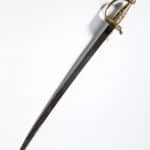
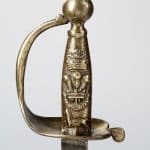
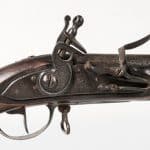
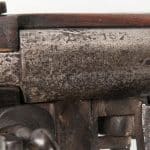


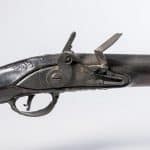




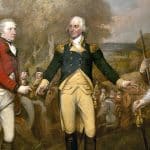



Related posts: